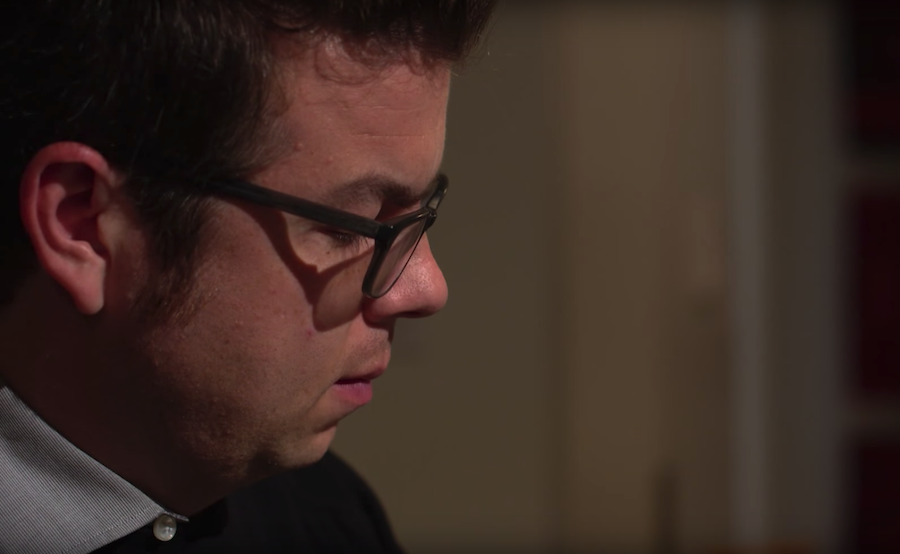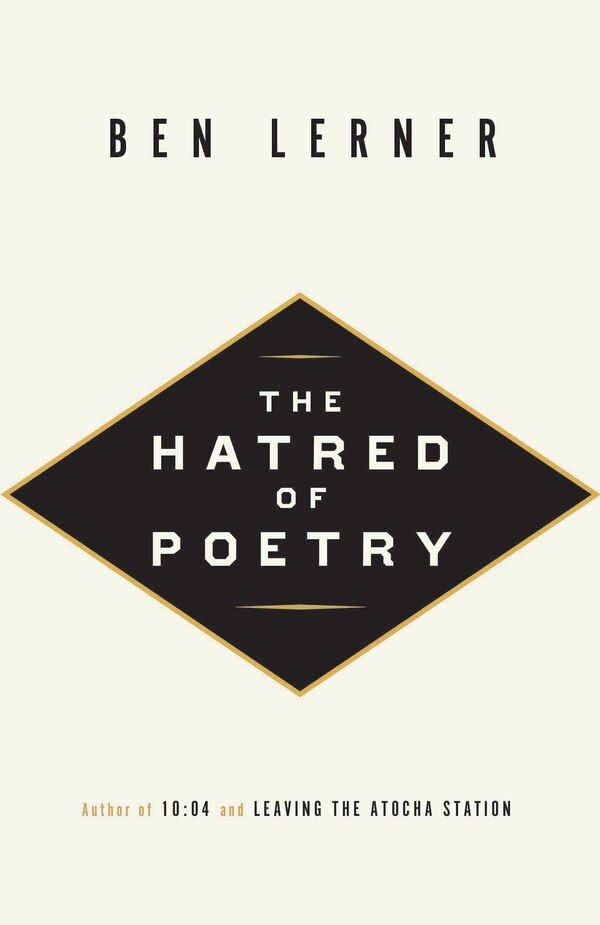With Stories Like These
With Stories Like These, Who Needs Talent? Part III: The Spirit of the Age
Lerner earned a BA in Political Science from Brown University, as well as an MFA in poetry from the same institution.

This is the third part of a 4-Part series of essays by the author, entitled “With Stories Like These, Who Needs Talent?” Part Two can be found here.
Ben Lerner is arguably the most distinguished young writer in America, equally well-known as a poet, critic, essayist, and novelist. His oeuvre may be the single most critically-acclaimed, award-winning, institutionally-validated body of work by any living English-speaking writer under the age of fifty.
Lerner was born in 1979 in Topeka, Kansas. His parents are well-known psychologists; his mother Harriet Lerner’s book The Dance of Anger (1985; revised 2005) has sold millions of copies. Lerner earned a BA in Political Science from Brown University, as well as an MFA in poetry from the same institution. He won the Hayden Carruth Award for Emerging Poets for his first book (2004); a Fulbright Scholarship to travel to Spain to write his second book of poetry; the Believer magazine’s Believer Book Award for his first novel Leaving the Atocha Station (2011); the New York Public Library’s Young Lions Prize (2011); a Guggenheim Foundation Fellowship (2013); the Terry Southern Prize from the Paris Review (2014); and a $625,000 “Genius Grant” from the MacArthur Foundation in 2015. Since 2016, he has been a Distinguished Professor of English at Brooklyn College (part of the City University of New York). He has been selected as one of the judges for the 2018 Griffin Prize in Poetry, one of the world’s most lucrative literary awards.

Lerner writes poetry in the tradition of John Ashbery. One of the more coherent poems from The Lichtenberg Figures (2004) runs thus in its entirety:
True, a great work of art takes up the question of its origins
and lets it drop. But this is no great work. This is a sketch
sold on the strength of its signatures, a sketch
executed without a trial. Inappropriately formal,
this late work reflects an inability to swallow. Once
my name suggested female bathers
rendered in bright impasto.
Now it is dismissed as “unpronounceable”, or
Polemical, depressed, these contiguous blank planes
were hung to disperse museum crowds. Alas,
a generation of pilgrim smokers
has arrived and set off the sprinklers.
True, abandoning the figure won’t change the world.
But then again, neither will changing the world.
On paper this almost mimics the form of a Shakespearean sonnet, except that there is no regular rhythm or line length, or rhyme scheme, or formal discipline, or anything other than its arrangement on the page to distinguish it from a few sentences of prose. Inexperienced readers who do not instantly see the merits of this should be aware that this is what prize-winning English poetry looks like in the Creative Writing era.
Lerner’s 2016 volume No Art collects his three books of poetry, along with a handful of more recent poems (including “No Art,” which was published in the Paris Review’s Winter 2012 issue). There is a definite (if faint) development in his work, as his phrases gradually lengthen and his trains of thought become more elaborate. Angle of Yaw (2006) contains a great many prose poems, and Lerner’s first published attempts at overtly political poetry. His 2010 collection Mean Free Path gains by being read straight through in a single sitting, because there is a great deal of repetition, which is meant to form a pattern of motifs. Though his earnest, straightforward approach does not lend itself well to the type of theoretical, abstract, intellectualised poetry he aims to compose here. Of course, by 2010, Lerner’s energies were no longer focussed primarily on poetry. He had decided to become a novelist, of sorts.
Lerner’s manner of writing fiction involves creating a narrator based almost entirely on himself and then using his voice faithfully to transmit thoughts, observations, and memories in order to create an illusion of consciousness. This is done at the expense of narrative development, character, and formal structure; the result succeeds only insofar as the illusion maintains the reader’s interest.

Leaving the Atocha Station (2011), Lerner’s first novel, is mostly indistinguishable from an autobiographical memoir. The story is fairly simple: a professional American poet named Adam Gordon wanders around Madrid during the 2003/2004 academic year. Having won a prestigious fellowship to complete a literary project that he has no intention of even starting, he tries to ingratiate himself with a group of cultured left-wing intellectuals, whilst not quite having a love affair, failing to learn Spanish, and ruminating a great deal about Topeka, Brown University, John Ashbery, and film.
In chapter four, a bomb goes off at the Atocha Station; this grounds the novel in contemporary history, and (perhaps) the author’s experience, because Lerner was likely in Madrid on a fellowship on 11 March 2004, when 192 people were killed in the worst terrorist attack in Spanish history. Though this event also has a literary resonance: “Leaving the Atocha Station” is the title of a poem in John Ashbery’s 1962 collection The Tennis Court Oath.
The few invented elements in Leaving the Atocha Station can usually be distinguished from memory-based material by a certain clumsiness. Towards the end of Chapter Two, Adam Gordon chats over instant messenger with a friend in Mexico who watched a girl die during a swimming trip. The conversation inevitably turns into a discussion on novel-writing and “real experiences.” This may well be based on a real incident from Lerner’s past; though the instant-messenger exchanges are unconvincingly ‘literary’ in rhythm and tone, and read too much like Lerner’s verse. Of course, Lerner does feel free to fabricate elements of his past: at the beginning of the same chapter, Adam Gordon reads out a poem which sounds like it came from Lerner’s 2010 collection, rather than his choppier 2004 book.

Lerner’s second novel 10:04 (2014) is written in a smoother, richer prose than that of Leaving the Atocha Station. The author tries harder to shape his memories artfully, though this is still an attempt to download the author’s experience into the reader’s mind with as little editing as possible. In 10:04, the narrator (“Ben”) struggles to complete a second novel after his first is excerpted in the New Yorker, leading to a six-figure advance from a publisher and unprecedented public attention. In 2012, the New Yorker published Lerner’s story “The Golden Vanity” (18 June issue); this text is unsurprisingly included in the body of 10:04.

By the standards of contemporary critical theory, English literature studies, and Creative Writing conventions, it would be naïve and unsophisticated to identify the narrator of 10:04 as a barely-fictionalised version of the author. “Ben,” unlike Ben Lerner, is neither a husband nor a father. Yet Chapter Four describes experiences during the narrator’s stint as a writer-in-residence at an artists’ colony in Marfa, Texas, where Ben Lerner also lived as a writer-in-residence in Marfa in 2012. The main conflict in Lerner’s ‘autofictions’ lies in the distinction between real-life events and made-up ones. Lerner does not obviously think too hard about this distinction, or why it might interest the reader.
Lerner is likely working on a third novel, an excerpt of which was published in the New Yorker as “The Polish Rider” in the 2016 Fiction Issue (6-13 June, 2016). Again, this is less a short story than a ruminative essay in the form of a short story. “The Polish Rider” may be Lerner’s most accomplished attempt at ‘autofiction’ so far, and it gives a fair idea of what his longer pieces are like. His essays are like this too. All his work, in fact – prose or verse, fiction or non-fiction – is written in the same voice, and interspersed with similar-sounding thoughts about aesthetics, popular culture, left-wing politics and a Topeka childhood.
The title “The Polish Rider” refers, not only to Rembrandt’s painting of that name (held by the Frick Collection), but also to Sonia, a Polish artist who accidentally leaves all of her paintings in the back seat of an Uber taxi the night before her exhibition opens. The unnamed narrator, who has written an essay for the show, tries to help Sonia locate the paintings; they visit the Uber offices, the police, and finally the Uber’s driver. “The Polish Rider” terminates before a conclusion is reached, though it seems that the paintings will in fact never be recovered; instead the narrator will write a new essay about them. The basic premise of this story is potentially farcical; but Lerner insists on making it a vehicle for his narrator’s internal monologue.
Whilst the narrator of “The Polish Rider” is a writer, and the other named characters include an artist and an art dealer, there is no sense that any of these people is more ‘cultured’ or better-informed than the policeman, the Uber employees, or the Uber driver with whom they interact. The narrator spends a great deal of time talking and thinking about American mass culture, and in particular the 1970s TV sitcom Taxi, which starred Danny DeVito and Judd Hirsch. These reflections begin with his comparisons of the Uber offices to the garage where most of Taxi is set, and of Uber staff members to the character played by DeVito; but his reflections soon take on a life of their own:
…Then I realised how ridiculous it was that my nostalgia for a previous mode of labour and travel was actually nostalgia for an earlier moment of TV, and the image of New York it had introduced to me in Topeka in the form of reruns I watched with my dad, who looks a little like Judd Hirsch. (I asked Sonia if she’d ever seen Taxi. “Yes,” she said. “De Niro.” She pretended to produce a gun from her sleeve.) By the time Miles was before us, smiling, my head was empty except for Taxi’s melancholy theme song, composed the year before Honecker and Brezhnev kissed, before Sonia and I were born, and I thought that the tone of the theme song, the range of feeling it could hold, was wider and deeper and messier around the edges than anything we heard on television now. In fact, wasn’t television supposed to be better than ever before? Wasn’t I always envying the HBO miniseries, its ability to depict systems?
Sonia’s confusion of the TV series Taxi with the 1976 film Taxi Driver is meant to be a significant joke, which will of course be lost on any reader unaware of these references. Traditional ‘high culture’ is not one of Lerner’s usual preoccupations; he would appear to prefer discussing films that he watched as a child, such as Ghostbusters.

For all his obsession with mass culture, Lerner maintains some pretension to a conventional intellectual status; this is manifest in his narrator’s frequent attempts to philosophise about Sonia’s situation:
As [Police Sergeant] Kingdom and I waited for Sonia’s response, I thought about how the missing paintings were undergoing change as we chased them. The paintings would be different in some essential sense if we found them discarded in an alley or hanging reverently in someone’s home. I mean that the story attached to the paintings would inflect them conceptually from now on, at least for us: if Sergeant Kingdom frightened a member of a heavily surveilled population into yielding information that led to the paintings’ recovery, then the paintings would depict false fraternity propped up by secret police; if some benevolent stranger returned them through Uber, then the kiss would have a new glimmer of sociality, at least suggest the possibility of communal spirit instead of its evacuated image.
For Lerner, the experience of art is intensely personal: a work of art or a literary expression can best be understood by its creator, and only comprehended fully within his own milieu. His private references are not necessarily self-indulgent; but he does not aim to communicate with an especially wide or diverse audience. Lerner’s intended audience likely consists of other writers; in this sense he represents a logical development of institutionalised Creative Writing, where literary work is shaped by, and specifically composed for, the context of a writers’ workshop.

Lerner’s fullest attempt to articulate his thoughts about literature will be found in his 2016 volume The Hatred of Poetry, which is an expansion of a 4,000-word ‘Diary’ column for the London Review of Books (18 June 2015). The extended version runs to fewer than a hundred pages, even in a small format with large type and generous spacing on the page. It is not obvious that the essay needed expansion, or that Lerner has added much to his original insights.
Lerner’s starting point is the work of his former mentor Allen Grossman (1932-2014), who was also the recipient of a MacArthur Foundation “Genius Grant” and a Guggenheim Fellowship in his day. Grossman’s 1997 book The Long Schoolroom is mentioned on the acknowledgements page of Leaving The Atocha Station, and also supplies much of the inspiration for Lerner’s thoughts on poetry generally.
Insofar as The Hatred of Poetry has a focussed purpose, it is to rehash Grossman’s argument that no single poem can ever live up to a poet’s ideal of what poetry should be, or do. Lerner does not himself argue the point, so much as quote Grossman’s assertions of this idea, or paraphrase sections of Grossman’s essays that seem to support the point. In the middle of a discussion of the Scottish poetaster William McGonagall (1825-1902) he mentions, in parentheses:
I just got off the phone with my friend, the poet and critic Aaron Kunin – also a student, not coincidentally, of Grossman’s – and mentioned my reading of the “Tay Bridge Disaster,” only to be told by Kunin that Grossman obtained his job at Johns Hopkins by giving a talk on McGonagall and the Tay Bridge poems.
The literary critic Michael Clune, whose thoughts on Keats Lerner is honoured to appropriate, also turns out to have studied under Grossman. Lerner finally interrupts himself in the middle of a political discussion about Walt Whitman (“In many ways ‘Walt Whitman’ is less a historical person than a place holder for democratic personhood”) to admit:
To quote Grossman’s brilliant essay on Whitman – as I write this monograph I come to realise with greater and greater clarity how central Grossman’s thinking is for me.
Later on, he notes: “Today, June 29, 2014, Allen Grossman died.” The book ends shortly thereafter.
Lerner’s knowledge of poetry appears to be almost entirely second-hand: when not rewriting Grossman’s thoughts, he quotes at length from Claudia Rankine (also the recipient of a MacArthur Foundation “Genius Grant”), Beth Loffreda (author of Losing Matt Shepherd in 2000, and co-editor with Rankine of The Racial Imaginary in 2015), the modernist poet/critic/scholar/essayist Guy Davenport (1927-2005), Peter Bürger (1936-2017, and author of the once-influential 1974 study Theory of the Avant-Garde), and the postmodern poet/critic/scholar/essayist Susan Howe, whose thoughts on the poetry of Emily Dickinson are borrowed without being credited to the original author.
When Lerner attempts to discuss Plato’s Republic with relatively minimal help from Grossman et al., he ends up dwelling on his memories of reading Plato as a teenager in a library in Topeka, then quotes himself from the beginning of Leaving the Atocha Station. He helpfully points out that “in college at the end of the last millennium the coolest young poets I knew were reading Rimbaud and Oppen,” before finally confessing with a blush: “I was reading Rimbaud on the green, careful to be seen, but I was also reading, savouring, the worst poets in English.” The Plato digression was spliced into the original London Review of Books essay with little evident thought for whether it would cohere with the rest of the discussion.
Lerner’s own original ideas about poetry are conspicuous by their absence; there is a single perfunctory attempt at a close reading of McGonagall, which is scattershot and unconvincing, because Lerner fails to grasp why McGonagall has been ridiculed for a century and a half as one of the very worst poets in English literature.
McGonagall was a deluded autodidact who was convinced of his own greatness as a poet, and oblivious to criticism or mockery. His reputation only makes sense within a culture where a poet can gain genuine public acclaim thanks to a large audience of informed, discerning readers. Modern readers in the English-speaking world have, as a rule, so little exposure to poetry that McGonagall’s lack of talent is no longer self-evident. He simply seems old-fashioned because of his high-flown diction, air of solemnity, and insistence on rhyme. His work only reveals its poverty in comparison with poems by figures whom he strove to emulate. If you do not know Shelley, Wordsworth, or Tennyson well, McGonagall’s failure as an artist might not be immediately obvious, despite Lerner’s claims to the contrary.
A Creative Writing workshop-style criticism of McGonagall’s inept prosody does not seem a particularly damning indictment. For all his technical incompetence and shockingly tactless, tasteless bathos, McGonagall does not in fact look so bad compared to most contemporary institutionalised poets. At least his work is memorable in its way, and could once command some public attention. But Lerner is not interested in McGonagall except as an excuse for rambling free-association around the theme of poetic ambition.
Why does Lerner not risk a critical discussion of a poem he thinks genuinely important – one of John Ashbery’s, say?
Lerner’s citations are not uniformly reliable. The Hatred of Poetry features an intemperately angry response to George Packer’s 2008 New Yorker blog post in which he questioned the wisdom of commissioning a poem for President Obama’s inauguration ceremony. Obama chose Elizabeth Alexander, a professor of African-American Studies at Yale, as poet laureate for his inauguration. Lerner implicitly accuses Packer of racism and misogyny, and makes snide remarks about Packer’s suggestion that the Nobel Prize-winning Trinidadian writer Derek Walcott (1930-2017) would have been ideal for the ceremony (as he would indeed have been, if audience appeal and literary merit were among the selection criteria). Lerner does not mention that Packer felt compelled to write an apologetic retraction to his original post to answer charges of racism and misogyny; nor does he accurately characterise the substance of Packer’s concern.
Packer is not a “poetry hater” or (as is insinuated) a nostalgic reactionary with a deludedly romantic vision of what poetry was once like. He simply thought it would be a bad idea to invite Alexander to read her work in front of an audience of millions, given its self-evidently limited appeal. Lerner does not think to read Alexander’s inauguration poem or watch video of her reading to check whether or not Packer’s concerns turned out to be prescient. It is hard to figure why Lerner chose to put so many words into Packer’s mouth, since he is used mainly as a means to link Peter Bürger’s thoughts on the avant-garde with Allen Grossman’s reflections on Walt Whitman.
However, his unfairness to George Packer is nothing compared to his defamatory attack on Mark Edmundson. Edmundson, a Professor of English at the University of Virginia, made the mistake of publishing an essay on Creative Writing poetry in Harper’s in July 2013. He criticised institutionalised poets’ self-absorption and solipsism; he ridiculed the MFA system; he made fun of “theory-induced anxiety” and poets’ craven fear of identity politics; he singled out John Ashbery for particularly harsh censure.
Edmundson’s essay contains a few questionable points and debatable judgments. But on the whole it seems convincing. Lerner represents it, incredibly, as a philistine right-wing rant. He accuses of Edmundson of being unfamiliar with the contemporary poets mentioned in his essay, and claims that Edmundson “considers speaking for everyone the exclusive domain of white men.” He sees paternalistic, patriarchal misogyny in Edmundson’s reading of Sylvia Plath, and patronising racism in Edmundson’s discussion of Amiri Baraka. This is nothing short of libel. It reflects badly on Lerner’s publishers that they allowed this material to be published. In the current climate it could have serious consequences for Edmundson, who does not deserve to be punished for disliking John Ashbery’s verse.
The Hatred of Poetry is valuable chiefly as a document of just how degraded literary culture has become in the age of Creative Writing. Lerner is not obviously outstanding as a poet; as a novelist he has a certain gift for describing himself as a self-pitying, self-hating neurotic; as a scholar and literary theorist he is helplessly reliant on the research and opinions of other writers; as a critic he combines slander with passive aggression. The overall impression is of a compulsive autobiographer who is not particularly learned or original, and whose character is far from admirable.
The Hatred of Poetry effortlessly reveals why contemporary poetry is no longer popular with readers, and remains the subject of widespread disdain (where anyone pays attention to it at all); though not in a way that the author intended. There is nothing to learn from Creative Writing poetry, and more pleasure in it for the writer than the audience, which is made up mainly of others who want to have their turn inflicting their poetic thoughts and feelings on as much of a public as can be made to pay attention. Why would any normal person want to read this sort of thing?






